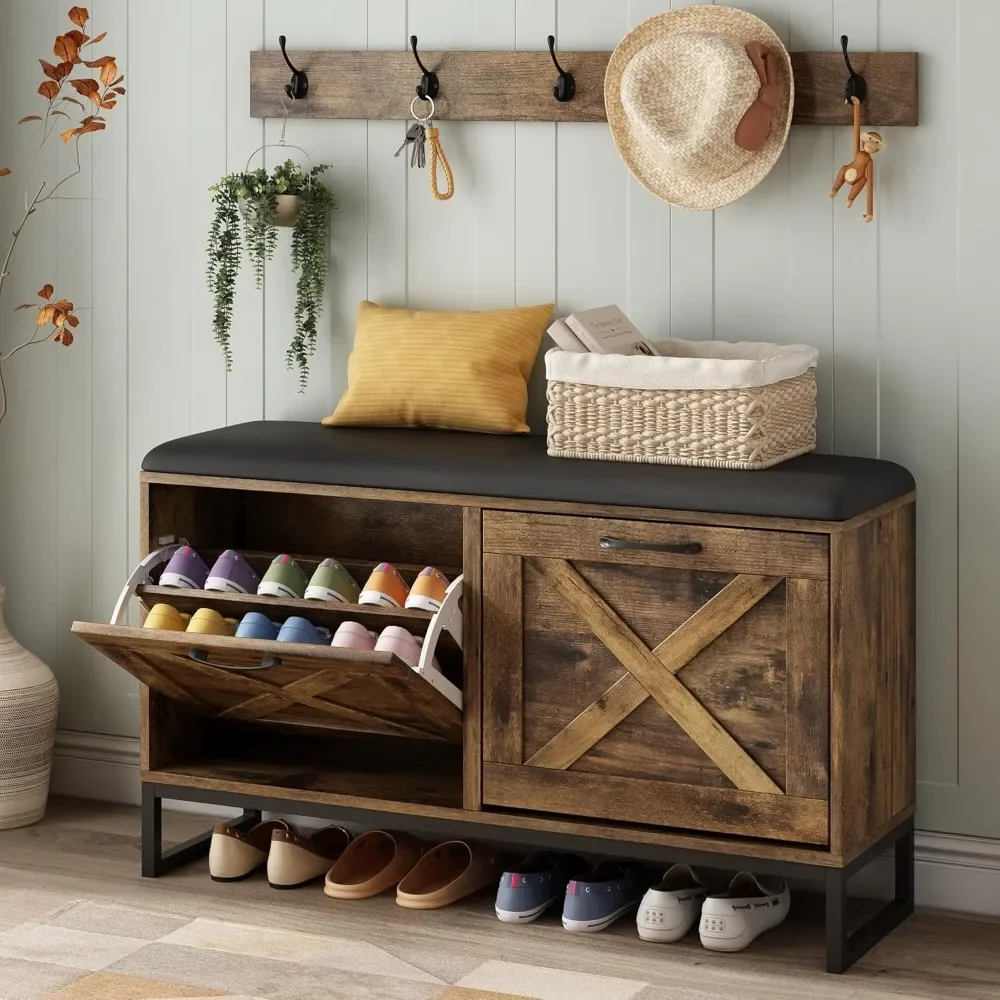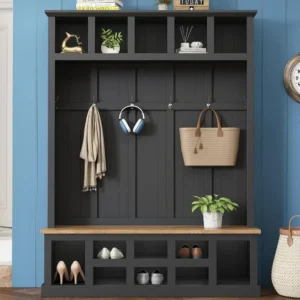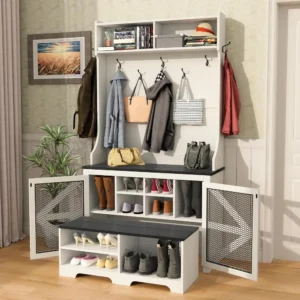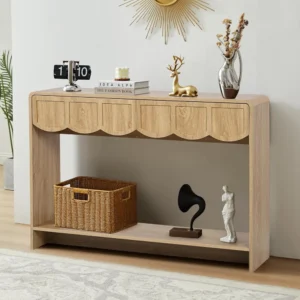Creating an Inviting First Impression: Why Your Entryway Deserves Attention
Your entryway is much more than just a passageway—it’s the first chapter of your home’s story. This small but mighty space creates the initial impression for both you and your guests, setting the tone for the entire home experience. When designed thoughtfully, your entryway can transform from a chaotic drop zone into a welcoming, organized space that makes coming home a pleasure.
Studies show that organized spaces significantly reduce daily stress levels, with nearly 80% of people reporting that they feel more relaxed in tidy environments. Your entryway serves multiple crucial functions—it’s where you transition from the outside world to your personal sanctuary, store everyday essentials, and welcome visitors into your home.
The perfect entryway solution combines practical storage with comfortable design elements. By integrating a bench with coat rack features, you address multiple needs at once: a place to sit while removing shoes, storage for outerwear, and a dedicated home for keys, bags, and other daily items. This combination of functionality creates an organized system that makes your daily comings and goings smoother.
The right entryway seating ideas can dramatically change how you use and experience this space. Throughout this guide, we’ll explore how to select, create, and style the perfect bench and coat rack solution for your unique space, blending functional storage with design elements that enhance your home’s aesthetic appeal.
Dual-Purpose Design: Benefits of Combining Bench and Coat Rack Features
When you combine a bench and coat rack into one entryway solution, you create a powerhouse of functionality that transforms how your entire household uses this space. This smart combination offers far more than just the sum of its parts.
Space Optimization
Whether you have a spacious foyer or a compact apartment entrance, combining seating and storage in one piece maximizes your available square footage. Instead of placing separate furniture pieces that can make a small entryway feel cluttered, an integrated unit creates a cohesive, streamlined look. Even in larger spaces, this combination allows you to dedicate more room to circulation and movement rather than disconnected furniture pieces.
Organizational Excellence
Professional organizers agree that clutter accumulates when items lack a designated “home.” A bench-coat rack combination creates specific zones for different categories of belongings: hooks for coats and bags, shelves or cubbies for shoes, and perhaps drawers for smaller items like gloves and scarves. Many entryway benches with hidden storage offer additional space for seasonal items or rarely used accessories, keeping them accessible but out of sight.
Functional Convenience
The simple addition of seating transforms your daily routine. Rather than hopping on one foot to remove boots or awkwardly bending to tie shoelaces, a bench provides stable, comfortable seating that makes transitions smoother. This feature is particularly valuable for families with young children who need help with shoes and outerwear, or for anyone with mobility concerns.
Aesthetic Enhancement
Beyond pure functionality, these combination pieces serve as an opportunity to establish your home’s design personality from the moment someone steps inside. Available in countless styles from rustic farmhouse to sleek contemporary, hall trees and coat rack benches can be selected to complement your existing decor or make a statement as a focal point. This cohesive approach to entryway design creates a more intentional, polished look than mismatched separate pieces.
A well-designed entryway hub reduces morning stress by ensuring everything you need is organized and accessible. Keys have a designated hook, umbrellas have a proper stand, and seasonal accessories stay neatly contained rather than scattered throughout the home. This organization transforms your departure and arrival routines into smooth, stress-free experiences.
Design Foundations: Essential Planning Considerations for Your Entryway Setup
Before selecting the perfect entryway solution, taking time to properly plan will ensure you choose a system that truly meets your household’s needs. These foundational considerations will guide you toward the ideal bench and coat rack combination for your specific situation.
Space Assessment
- Measurements Matter: Take precise measurements of your entryway’s width, depth, and height. Include these in your shopping notes to quickly eliminate options that won’t fit.
- Door Clearance: Allow at least 30 inches of clearance for door swing and traffic flow. Mark this space with painter’s tape to visualize the usable area.
- Wall Space Evaluation: Note the available wall space for mounting hooks or taller units, accounting for light switches, outlets, and existing fixtures.
- Ceiling Considerations: For tall hall trees or built-in units, measure ceiling height and note any sloped areas that might impact installation.
Remember that proper scale is crucial—an oversized unit in a small space will feel cramped, while a too-small piece in a grand foyer will appear insignificant.
Functional Requirements Analysis
- Household Inventory: Count the number of household members who will regularly use the entryway storage and multiply by the typical number of coats and shoes per person.
- Seasonal Assessment: Consider your climate and how seasonal needs fluctuate. Cold weather regions require more storage for bulky coats, boots, and accessories.
- Activity Analysis: Identify specific activities that generate entryway items—sports equipment, dog-walking supplies, school backpacks—and plan storage for these items.
- Guest Accommodations: Allow extra hooks and space for visitors’ belongings, especially if you frequently entertain.
The most effective entryway storage and seating solutions accommodate both everyday essentials and occasional needs without creating overflow.
Style Selection
- Design Harmony: Your entryway introduces your home’s design personality. Choose a style that complements adjacent rooms for visual flow.
- Architectural Alignment: Consider your home’s architectural features—ornate moldings might pair better with traditional styles, while clean lines call for contemporary pieces.
- Color Coordination: Select finishes that either blend seamlessly with existing woodwork or create intentional contrast as a design statement.
- Material Language: Different materials communicate different design messages—reclaimed wood speaks to rustic or industrial styles, while glossy lacquer finishes suggest modern aesthetics.
The style you select should feel like a natural extension of your home’s overall design language rather than an isolated decision.
Material Considerations
- Durability Factors: Entryways endure heavy use and exposure to outdoor elements. Solid wood offers longevity but may require more maintenance than engineered alternatives.
- Weather Resistance: If your door opens directly to the outdoors, choose materials that can withstand temperature fluctuations and occasional moisture.
- Finish Protection: Consider how different finishes stand up to daily wear—some show scratches more readily than others.
- Maintenance Requirements: Assess your willingness to maintain various materials—some require regular polishing or conditioning, while others need minimal care.
Investing in quality materials for this high-use area typically pays off through extended durability and sustained appearance, particularly for households with children and pets.
Ready-Made Solutions: Exploring Pre-Built Entryway Organization Systems
When looking for immediate solutions to entryway organization, the market offers numerous ready-made options designed specifically for this purpose. Each style has its strengths and ideal applications depending on your space and needs.
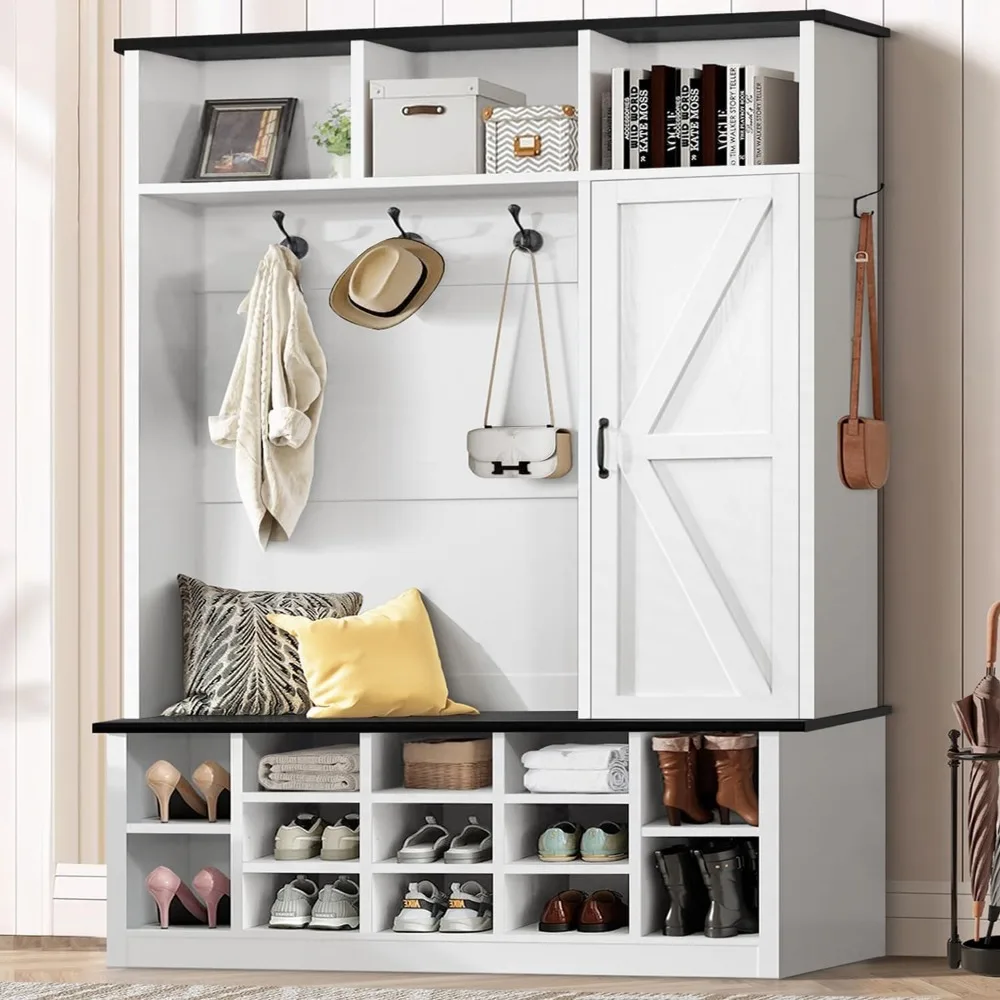
Hall Trees: The Complete Package
Hall trees represent the most comprehensive entryway solution, combining multiple functions into one cohesive unit. These all-in-one pieces typically include:
- A bench seat for comfortable shoe changes
- Coat hooks or a hanging rod for outerwear
- Shoe storage through cubbies or shelves
- Additional storage in drawers or cabinets
- Sometimes a mirror or decorative backboard
The standard hall tree ranges from 3-6 feet wide and 6-7 feet tall, though compact versions for smaller spaces exist. Their integrated construction means sturdier performance and consistent style throughout all components.
Entryway hall trees work particularly well in dedicated foyers or mudrooms where they can serve as a focal point. Their substantial presence creates a defined zone for arrival and departure routines, clearly communicating “this is where outdoor items belong.”
Bench and Coat Rack Combinations
For more flexibility or unusual spaces, separate bench and coat rack elements that coordinate visually offer another approach. These combinations provide:
- Independent pieces that can be arranged to fit your specific space
- Ability to replace or upgrade individual components over time
- Options for asymmetrical or unusual layouts
- Often a more budget-friendly initial investment
Installation typically involves securing the coat rack portion to wall studs for stability, while the bench remains freestanding. This approach works well for renters who may need to take their furniture when moving but still want a cohesive look.
These bench and coat rack combinations adapt particularly well to narrower entryways or hallways where a full hall tree might feel overwhelming.
Modular Systems for Custom Configurations
Modular entryway systems offer the ultimate in customization through mix-and-match components:
- Bench bases with various storage configurations
- Wall panels with adjustable hook placements
- Add-on cubbies, shelves, or cabinets
- Expansion potential as needs change
These systems typically use standardized dimensions so pieces work together seamlessly, allowing you to start with basic components and add more as budget allows. Installation complexity varies but often requires more planning than single-unit solutions.
Modular systems excel in growing families or homes where storage needs evolve frequently, providing adaptability without requiring complete replacement.
Design Style Categories
Different design styles offer distinct aesthetic approaches to entryway organization:
Modern/Contemporary: Features clean lines, minimal ornamentation, and often incorporates metal accents with wood or engineered materials. Typically employs hidden storage rather than open display.
Farmhouse/Rustic: Showcases natural wood tones, visible grain patterns, and sometimes distressed finishes. Often includes details like beadboard backs, barn door-inspired elements, or industrial hardware.
Industrial: Combines metal frameworks with wood elements, emphasizes function, and frequently uses pipe-style hooks or fittings. Creates a workshop-inspired aesthetic with durable materials.
Traditional: Offers refined details like crown molding, panel designs, and classic hardware. Usually constructed with richer wood tones and more formal proportions.
Mid-Century Modern: Features angled legs, organic curves, and warm wood tones. Typically more compact in scale with emphasis on clean lines and minimal ornamentation.
Key Features Worth Considering
Beyond basic structure, these features can significantly enhance functionality:
Shoe Storage Options: Compare open shelves (better air circulation) versus closed cubbies (neater appearance) or drawers (completely hidden storage).
Hook Configurations: Consider quantity (plan for at least 2 hooks per household member), placement height (including lower hooks for children), and style (decorative versus utilitarian).
Additional Storage Elements: Look for hidden compartments beneath bench seats, divided storage for small items, or special features like mail slots.
Special Add-ons: Evaluate the usefulness of mirrors (final appearance check before leaving), umbrella stands (containing drips), or message centers (family communications).
Most quality hall trees and bench systems range from $150-$800 depending on size, materials, and construction quality, with custom or luxury options extending significantly higher.
DIY Entryway Projects: Creating Custom Bench and Coat Rack Solutions
For those who enjoy hands-on projects or have specific space requirements that standard furniture doesn’t address, creating a custom entryway solution offers tremendous satisfaction and perfect fit.
Benefits of the DIY Approach
Custom-building your entryway organization system provides several advantages:
- Perfect dimensional fit for unusual spaces, including awkward corners or narrow hallways
- Significant cost savings, often 40-60% less than comparable ready-made options
- Exact material and finish matching to existing woodwork or furniture
- Opportunity to incorporate repurposed or sentimental materials
- Satisfaction of creating a personalized solution tailored to your specific needs
Many homeowners find that building their own entryway furniture allows them to maximize every available inch of space while creating something uniquely suited to their home’s character.
Project Planning Essentials
Before picking up any tools, thorough planning ensures success:
- Tool Assessment: Basic projects require a drill, saw, measuring tools, and sanding equipment. More complex builds might need routing capabilities or specialized joining tools.
- Skill Evaluation: Be honest about your woodworking experience—start with simpler projects if you’re a beginner.
- Material Selection: Choose between solid wood (more traditional, potentially more durable), plywood (stable, economical), or MDF (budget-friendly, good for painted finishes).
- Design Planning: Create detailed drawings with precise measurements, accounting for material thickness in your dimensions.
- Workspace Preparation: Ensure adequate space for construction and finishing, with proper ventilation for staining or painting.
For DIY projects, measure twice (or three times) before making any cuts to avoid costly material waste.
Custom hall tree storage design ideas can provide inspiration for layouts that maximize functionality while matching your aesthetic preferences.
Beginner-Friendly Project: Simple Wall-Mount System
For those new to woodworking, this project offers big impact with manageable complexity:
Materials Needed:
* 1×12 lumber for bench seat and shelf (approximately $30-40)
* 1×4 lumber for supports and coat rack board ($15-20)
* Decorative hooks ($20-30)
* Wood screws and wall anchors ($10)
* Stain or paint and polyurethane finish ($25)
This project involves creating a simple floating bench secured to wall studs, topped with a matching shelf, and a separate coat rack board mounted at appropriate height. The entire project typically takes a weekend to complete and requires minimal specialized tools.
The simplicity of this design makes it approachable for novices while still delivering functional elegance.
Intermediate Project: Freestanding Bench with Back Panel
This next-level project creates a more substantial piece with greater storage capacity:
Materials Needed:
* 1×12 lumber for bench seat and shelving ($50-60)
* 2×4 lumber for bench frame ($20-25)
* Beadboard or plywood for back panel ($30-40)
* Decorative hooks and hardware ($30-40)
* Wood screws and finishing supplies ($35)
This freestanding unit features a sturdy bench with shelf storage below and a tall back panel fitted with hooks. The construction includes more complex joinery and requires greater attention to stability, making it suitable for those with some previous woodworking experience.
The project typically takes 2-3 days and results in a substantial piece that anchors your entryway with custom-built character.
Advanced Project: Built-In Custom Entryway Unit
For experienced DIYers, creating a built-in unit offers the highest level of customization:
Materials Needed:
* Cabinet-grade plywood for structural components ($100-150)
* Hardwood for facing and trim ($75-100)
* Hardware including specialty cabinet fittings ($50-75)
* Finish materials including primer, paint, and sealants ($50)
This project involves constructing what essentially becomes architectural cabinetry—a permanent installation that integrates with your home’s structure. The process includes precise measurements, possibly removing baseboards, and creating a finished look that seamlessly blends with surrounding walls.
The advanced nature of this project makes it appropriate for those comfortable with cabinetmaking techniques, with construction typically taking 4-7 days depending on complexity.
Functional Styling: Organizing and Accessorizing Your Entryway Hub
Once your bench and coat rack structure is in place, thoughtful organization and strategic accessories transform it from simple furniture into a highly functional command center for daily life.
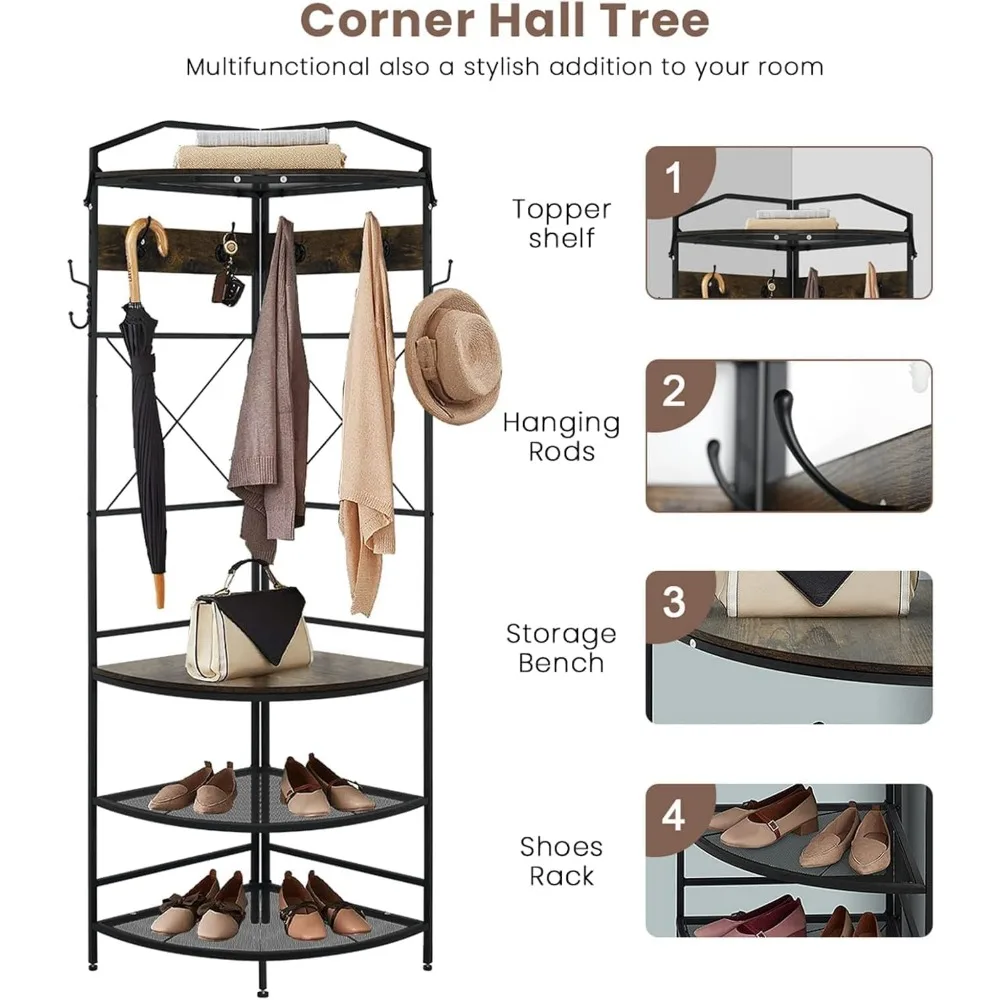
Practical Storage Accessories
The right containers and organizers dramatically increase the efficiency of your entryway:
Basket Collection: Use coordinating baskets in different sizes—larger ones for scarves and hats, medium for gloves and sunglasses, and small for keys and sunscreen. Natural materials like seagrass or water hyacinth add texture while metal or fabric options offer different aesthetic approaches.
Shoe Management: Consider boot trays for wet footwear, stackable shoe organizers for maximizing vertical space, or individual cubbies labeled for each family member. Waterproof liners in shoe storage areas protect wood finishes from dirt and moisture.
Small Item Control: Install key hooks at convenient height, use small dishes for coins and everyday jewelry, and create a specific spot for mail and papers to prevent counter clutter.
For homes with children, lower hooks and storage provide independence and encourage organizational habits from an early age. Corner hall trees offer excellent solutions for maximizing awkward spaces while providing comprehensive organization.
Comfort and Design Elements
Thoughtful additions enhance both the comfort and appeal of your entryway:
Seating Comfort: Add cushions or bench pads in washable fabrics for comfort and color. Consider seasonal rotation of cushion covers to refresh your space throughout the year.
Underfoot Elements: Place a durable, washable runner or entryway rug to define the space, protect flooring, and add visual warmth. Choose materials that withstand heavy traffic and are easy to clean.
Lighting Considerations: Ensure adequate overhead lighting for security and function, plus consider a small lamp or sconce for warm ambient light that creates a welcoming glow.
Reflection and Expansion: Position a mirror to reflect light and create the illusion of more space. A mirror also provides that final appearance check before leaving home.
These elements work together to create a space that feels intentionally designed rather than purely utilitarian.
Personalization Touches
Strategic personalization makes your entryway uniquely yours without creating clutter:
Wall Décor: Choose one statement piece or a small gallery arrangement above your bench to add personality without overwhelming the space.
Natural Elements: Incorporate a small plant (real or quality faux) to add life and color. Consider seasonal branches or flowers in a simple vase for easy updates.
Meaningful Objects: Display one or two special items that bring joy or significance—perhaps a beautiful bowl that holds your keys or artwork created by family members.
Signature Scent: Add a subtle reed diffuser with a welcoming fragrance that greets you and guests upon arrival.
The key is selectivity—in a high-traffic space, fewer thoughtfully chosen items create more impact than numerous small accessories.
Maintenance Systems
Creating simple systems ensures your organized entryway stays that way:
Daily Reset: Establish a 5-minute end-of-day routine to return items to their proper places.
Weekly Refresh: Schedule a quick weekly cleanup to wipe down surfaces, sweep or vacuum the area, and ensure all items are in their designated spots.
Seasonal Rotation: Create a quarterly system for rotating seasonal items to and from less accessible storage areas.
Family Involvement: Assign specific hooks and storage spots to each family member and establish expectations for maintaining order.
Professional organizers suggest the “one-in, one-out” rule for entryways—when adding a new coat or pair of shoes to regular rotation, remove a less-used item to prevent overflow.
Small Space Solutions: Maximizing Minimal Entryways with Smart Design
Limited square footage doesn’t mean sacrificing entryway organization. With strategic approaches, even the smallest spaces can incorporate both seating and storage functions.
Vertical Space Utilization
When floor space is at a premium, look upward:
- Install floating shelves above coat hooks to create storage without using floor space
- Stack functions vertically with hooks at different heights for adults and children
- Use over-door organizers for additional storage on entry doors or nearby closets
- Consider ceiling-mounted storage for seasonal or occasional items like sports equipment
Vertical storage maximizes your organizing capacity while keeping floor space open for movement. Multi-use furniture for small foyers offers creative solutions that adapt to compact spaces without sacrificing functionality.
Slim Profile Designs
Streamlined furniture preserves precious circulation space:
- Look for benches with depths of 12 inches or less that still provide adequate seating
- Choose wall-mounted options that eliminate legs altogether for maximum floor clearance
- Investigate corner units that tuck organization into otherwise unused angles
- Consider fold-down or convertible pieces that can expand when needed and collapse when not in use
Narrow entryway benches specifically designed for tight spaces offer the functionality of larger units while respecting spatial limitations. These streamlined options typically range from 24-36 inches wide with minimal depth, making them suitable for even the most compact entryways.
Visual Tricks for Tight Spaces
Strategic design choices can make small entryways feel more spacious:
- Place a mirror directly across from the entry door to visually double the space
- Choose furniture in lighter finishes or colors that recede rather than dominate
- Select pieces with exposed legs rather than solid bases to create visual lightness
- Install adequate lighting to eliminate shadows that can make spaces feel smaller
Glass or acrylic elements can also contribute to a lighter visual feel, as these transparent materials don’t interrupt sight lines the way solid pieces do.
For extremely tight spaces, sometimes the best solution is a miniature “landing strip” consisting of a narrow shelf with hooks above and a small stool or ottoman that can slide completely underneath when not in use.
Coat Rack Shoe Bench, Corner Entryway Bench, Corner Hall Tree, Shoe Bench for Entryway
$313.58 Select options This product has multiple variants. The options may be chosen on the product pageBench with Hooks and Storage, Entryway Hall Tree, Mudroom Bench with Cubbies, Mudroom Bench with Shoe Storage
$818.38 Select options This product has multiple variants. The options may be chosen on the product pageEntryway Coat Rack Bench, Entryway Hall Tree, Farmhouse Mudroom Bench, Mudroom Bench with Shoe Storage
$805.09 Select options This product has multiple variants. The options may be chosen on the product pageBench with Hooks and Storage, Entryway Coat Rack Bench, Entryway Hall Tree, Mudroom Bench with Shoe Storage, Mudroom Coat Rack Bench
$793.73 Select options This product has multiple variants. The options may be chosen on the product page- Price range: $785.40 through $897.63 Select options This product has multiple variants. The options may be chosen on the product page
Coat Rack Shoe Bench, Entryway Coat Rack Bench, Entryway Hall Tree, Wood Entryway Bench
$479.82 Select options This product has multiple variants. The options may be chosen on the product page
Seasonal Adaptations: Adjusting Your Entryway Organization Through the Year
Your entryway needs fluctuate significantly with the seasons. Creating flexible systems that adapt to changing requirements keeps this space functional year-round.
Winter Entryway Management
Cold weather brings specific organizational challenges:
- Install additional temporary hooks for bulky coats and jackets during winter months
- Add a boot tray with pebbles or a special mat to catch melting snow and prevent floor damage
- Create a dedicated basket for cold weather accessories like gloves, scarves, and hats
- Consider a small portable heater or boot dryer for extremely wet climates
During winter, prioritize moisture management to protect both your floors and furniture from water damage. Using waterproof containers and moisture-absorbent mats prevents damage while keeping wet items contained.
Summer Entryway Organization
Warm weather shifts the organizational focus:
- Create a sunscreen and bug spray station in an easy-to-grab container
- Designate hooks for lightweight items like sun hats and beach bags
- Add a basket specifically for summer accessories like sunglasses and water bottles
- Consider including a small towel station for pool days or water activities
Summer typically requires less hanging space for outerwear but more organization for recreational equipment and sun protection items.
Transitional Season Strategies
Spring and fall require the most flexibility:
- Use vacuum storage bags to compress off-season items while keeping them accessible
- Create a “weather station” with options for both warm and cool conditions
- Implement a rolling bin system that allows quick swapping of seasonal items
- Maintain a small selection of year-round essentials that remain constant
The key to transitional seasons is accessibility—items should be easy to retrieve when unusual weather patterns occur while keeping everyday essentials front and center.
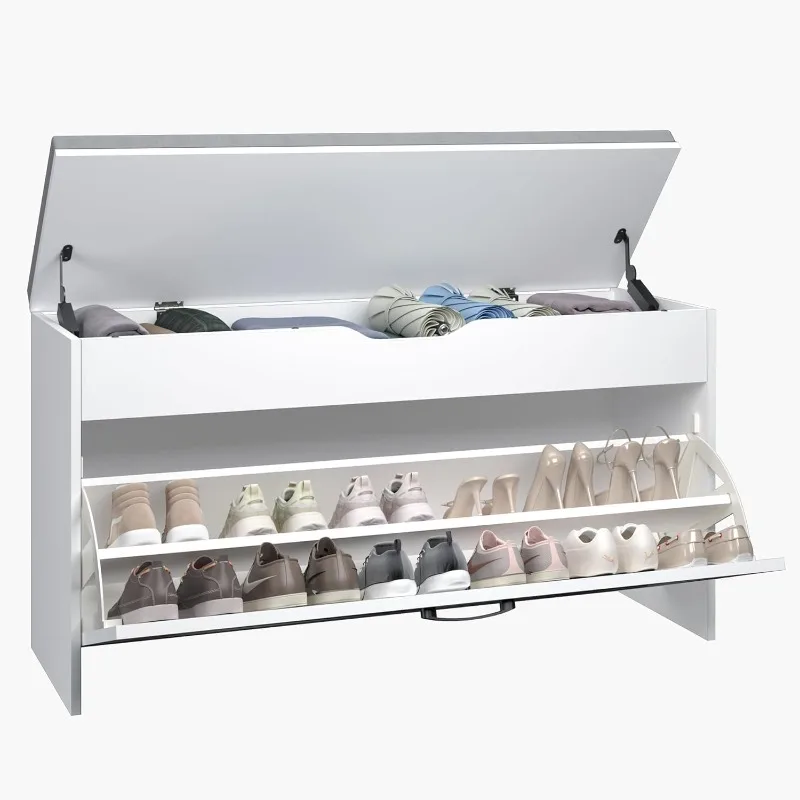
Entryway Integration: Connecting Your Entry Space with Adjacent Areas
Your entryway doesn’t exist in isolation—its design and function should connect harmoniously with surrounding spaces to create cohesive flow throughout your home.
Visual Flow Between Spaces
Create visual connection through thoughtful design choices:
- Select entryway furniture finishes that complement adjacent room color schemes
- Carry flooring materials or patterns from the entryway into connecting spaces
- Use consistent hardware finishes (doorknobs, hooks, light fixtures) to create continuity
- Consider sight lines from other rooms when arranging entryway elements
These connections help your entryway feel like an intentional part of your home rather than a separate functional zone.
Functional Connections
Consider how your entryway relates physically to other spaces:
- For entryways connected to kitchens, create smooth transitions for bringing in groceries
- When adjacent to living areas, consider acoustic buffering to minimize disruption
- If connected to staircases, ensure clear pathways and potential night lighting
- For open-concept homes, use furniture placement or area rugs to define the entryway as a distinct zone
Thoughtful placement of furniture creates natural traffic patterns that guide movement logically between spaces while maintaining the distinct purpose of each area.
Your Entryway Evolution: Maintaining and Updating Your Organization System
Like any well-designed system, your entryway organization should evolve as your household’s needs change over time.
Ongoing Assessment
Regular evaluation keeps your system functional:
- Periodically assess if your current setup meets your changing storage needs
- Notice if certain areas consistently accumulate clutter, indicating insufficient systems
- Consider how seasonal shifts affect your organization requirements
- Adjust hook heights and storage accessibility as children grow
Small adjustments made regularly prevent the need for complete organizational overhauls.
Refresh Strategies
Simple updates keep your entryway feeling current:
- Replace hardware for an instant style refresh without major investment
- Update bench cushions or add new storage baskets to introduce color trends
- Rotate artwork or mirrors to create visual change
- Add new lighting fixtures to transform the mood and functionality
These modest changes maintain visual interest while preserving the functional systems you’ve established.
Future-Proofing Your Entryway
Make choices that accommodate life’s changes:
- Select classic, adaptable designs rather than trendy pieces that may quickly feel dated
- Invest in quality construction that withstands years of daily use
- Consider adjustability features that grow with your family
- Create systems with some built-in extra capacity for future needs
The most successful entryway solutions anticipate change rather than merely addressing current requirements.
By thoughtfully designing your entryway with both current and future needs in mind, you create a space that welcomes you home day after day while smoothly adapting to life’s inevitable changes. The perfect combination of bench and coat rack features forms not just a functional zone but the warm introduction to your home that both you and your guests deserve.

